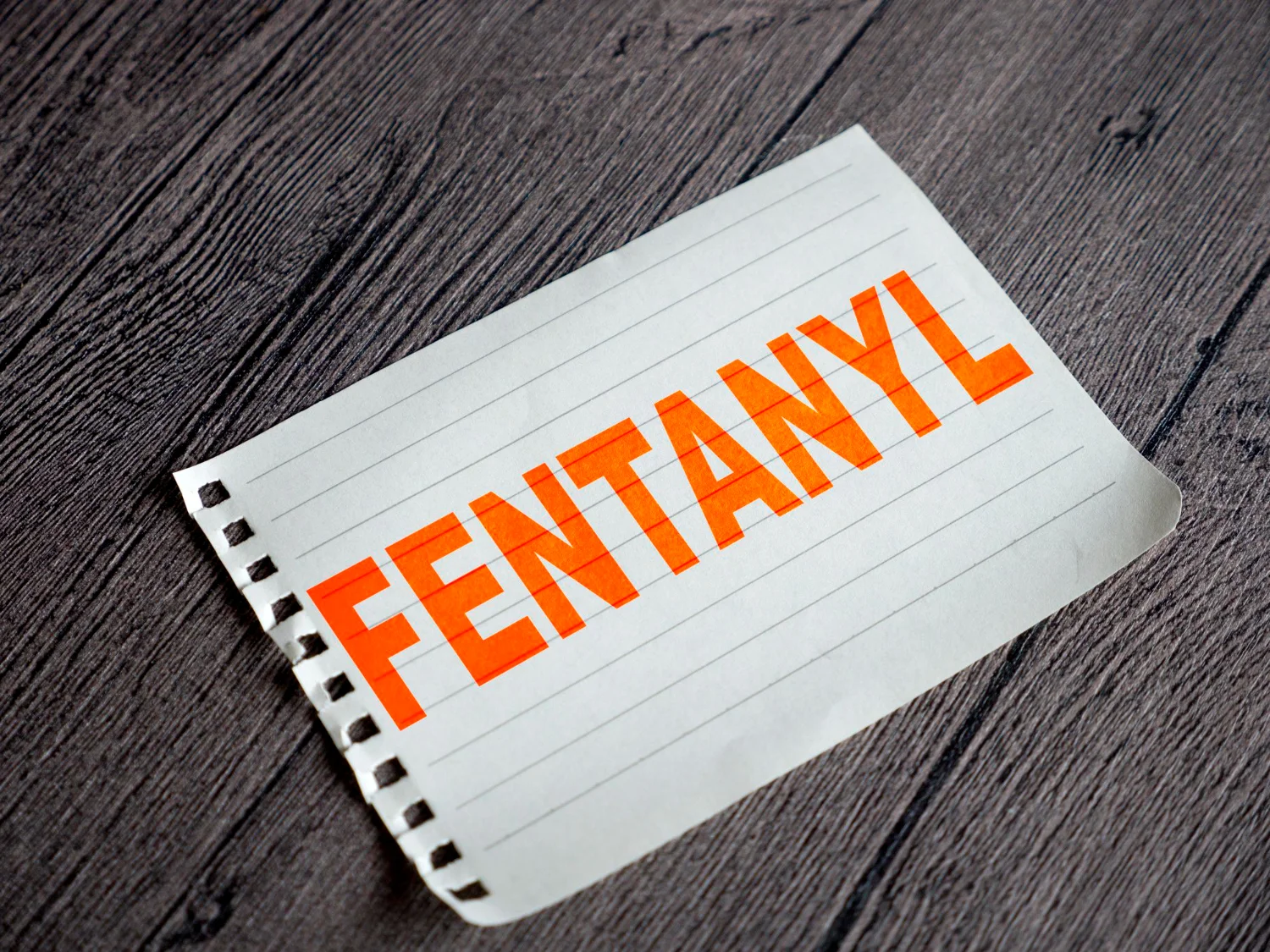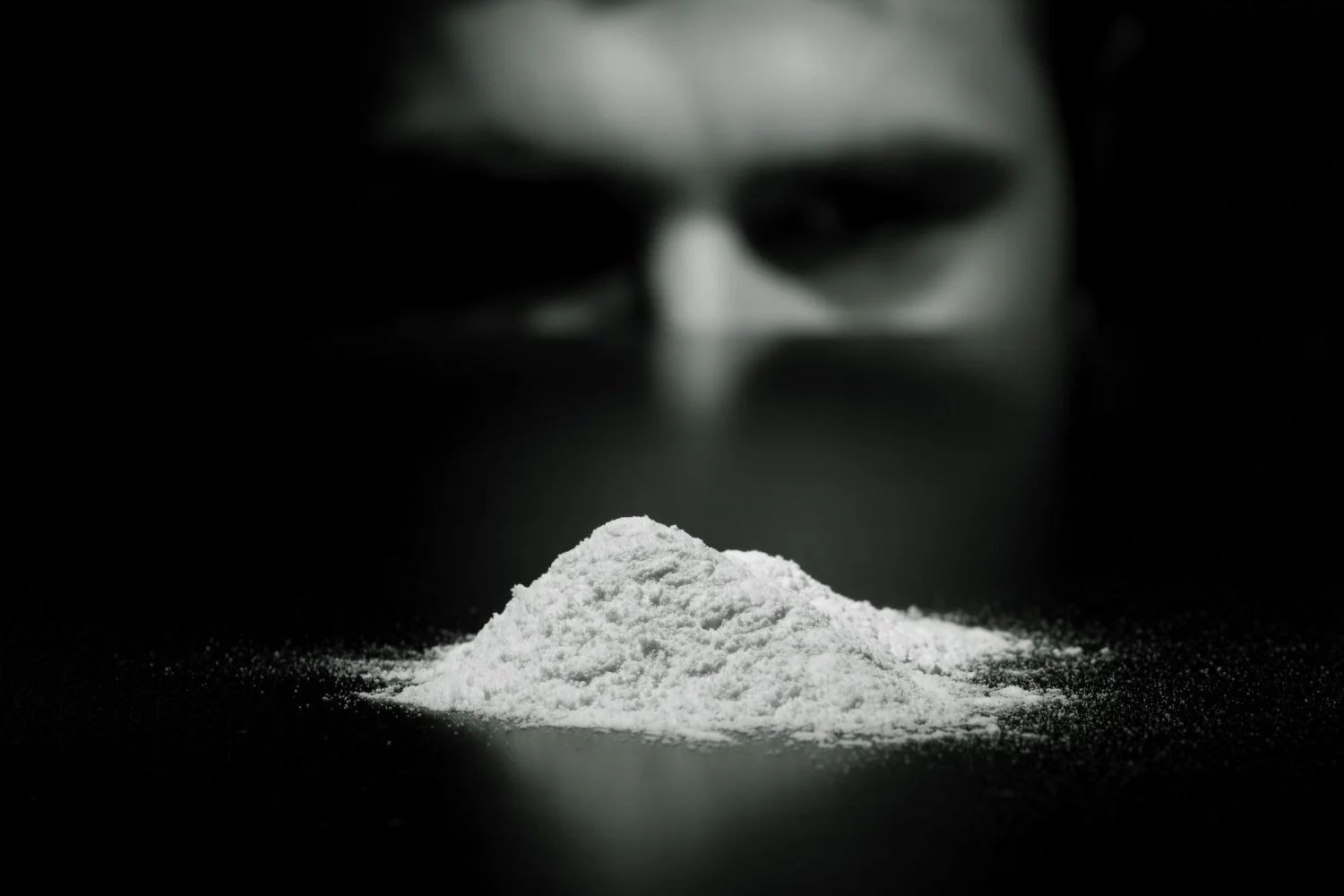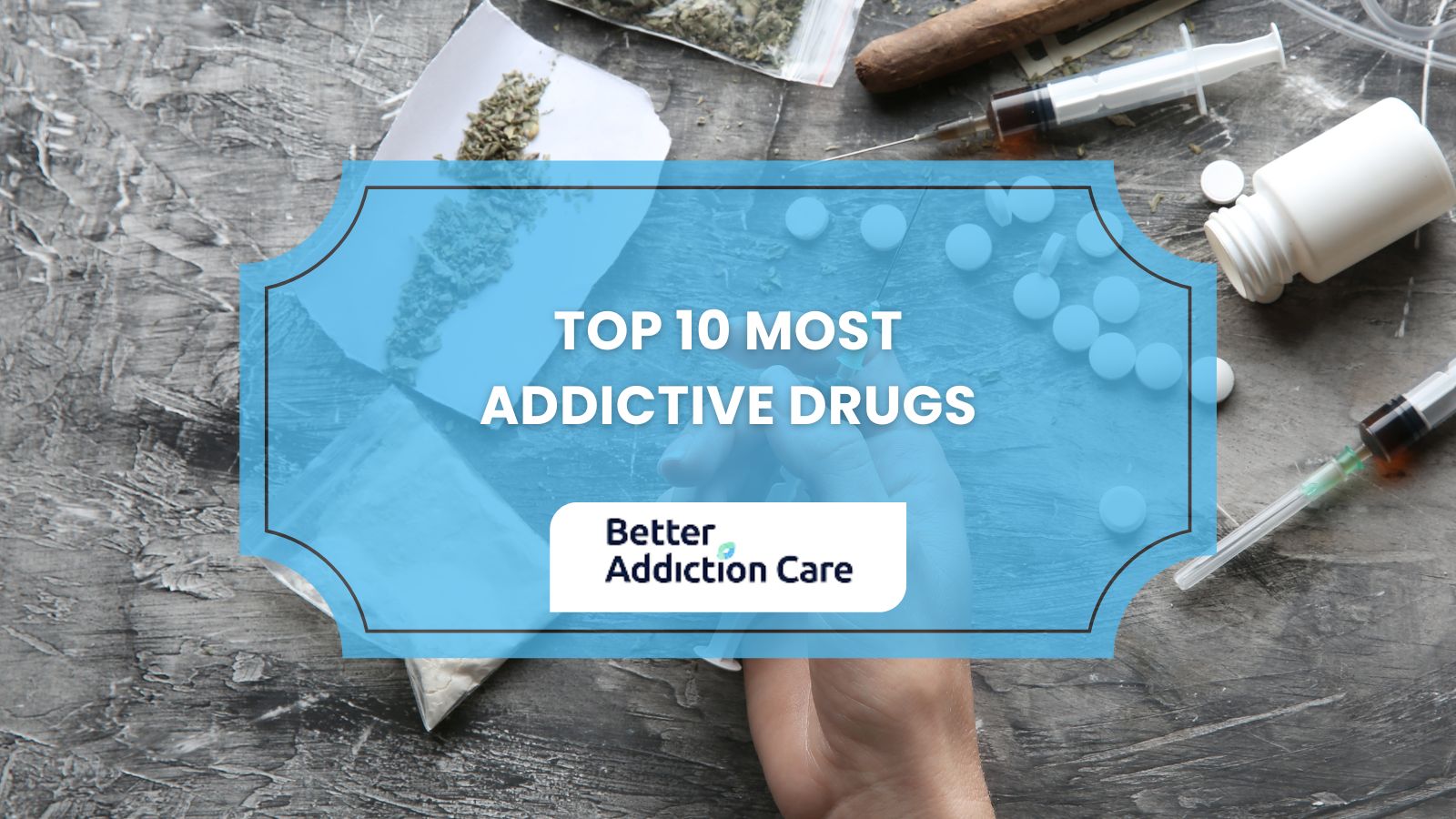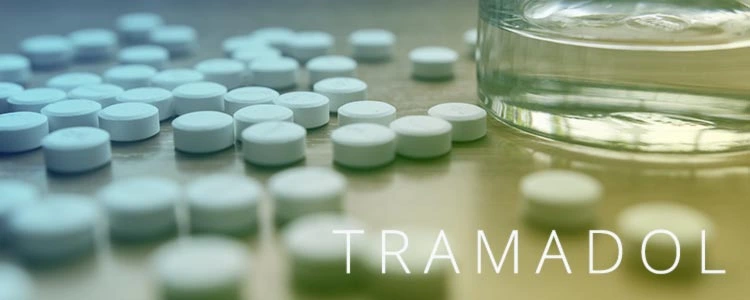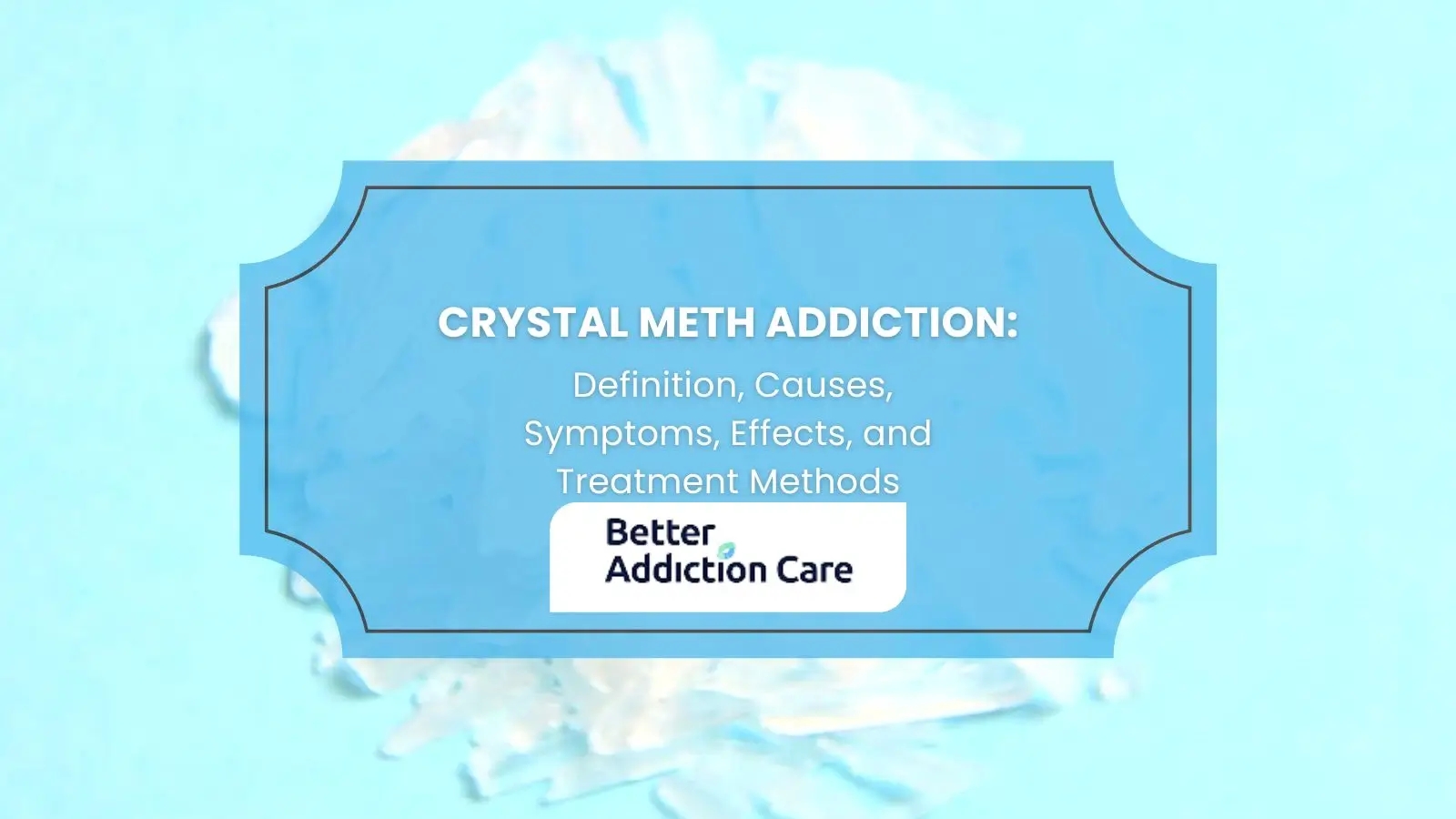Ritalin Addiction: Signs, Causes, Effects, and Treatment
Ritalin addiction occurs when the misuse of methylphenidate, commonly prescribed for ADHD treatment, leads to dependency and compulsive drug-seeking behaviors. The Centers for Disease Control and Prevention (CDC) reports that 6.1 million children in the U.S. are diagnosed with ADHD, and a significant portion are prescribed stimulants like Ritalin for treatment.
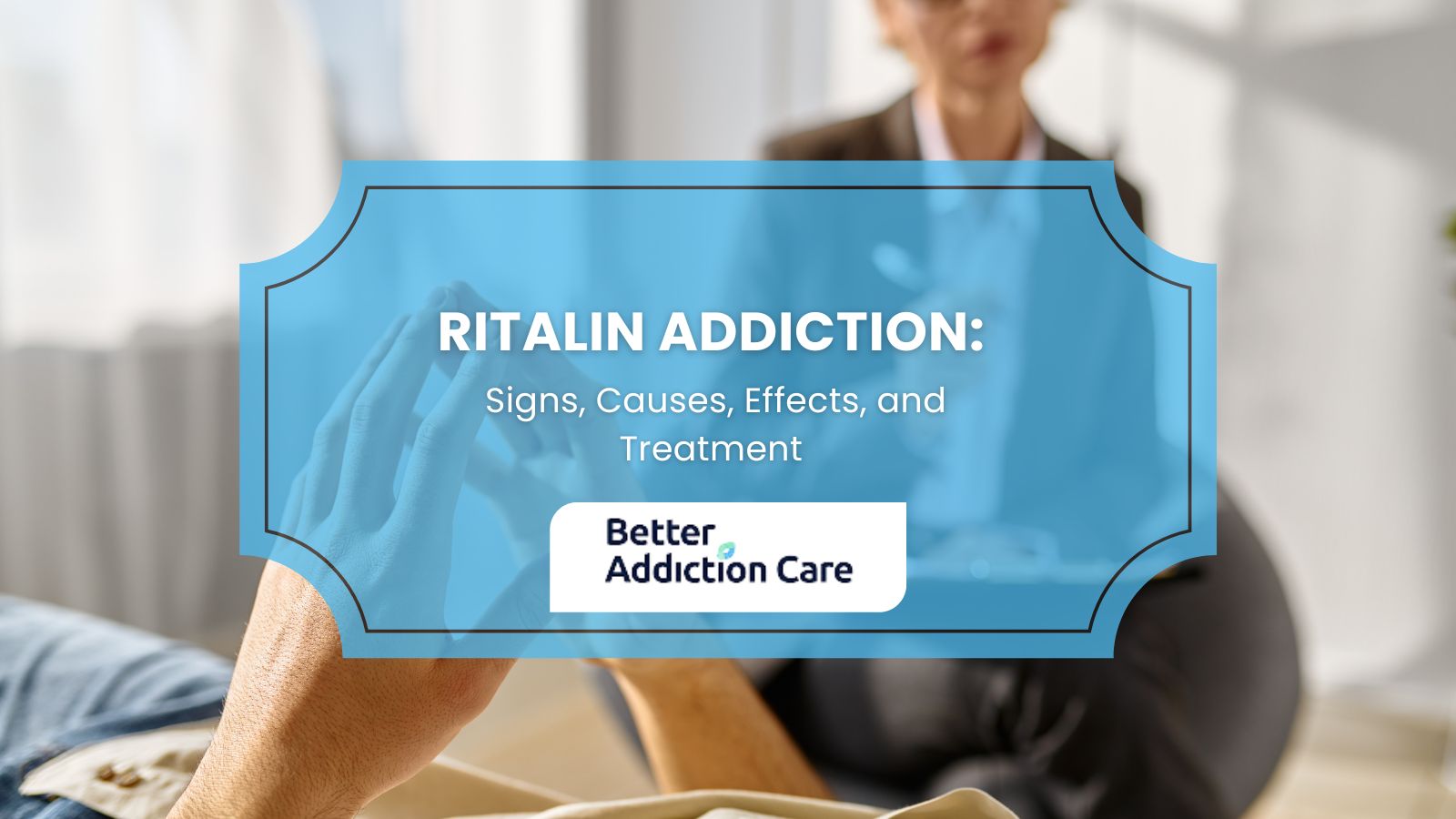
Ritalin addiction occurs when the misuse of methylphenidate, commonly prescribed for ADHD treatment, leads to dependency and compulsive drug-seeking behaviors. The Centers for Disease Control and Prevention (CDC) reports that 6.1 million children in the U.S. are diagnosed with ADHD, and a significant portion are prescribed stimulants like Ritalin for treatment.
The common signs of Ritalin addiction include cravings, withdrawal symptoms like fatigue and depression, insomnia, rapid heartbeat, and irritability. A study by McCabe et al. in “Patterns of Stimulant Misuse Among College Students” published in The Journal of Clinical Psychiatry (2009) reports behavioral changes such as secrecy, neglect of responsibilities, and financial issues as key indicators of methylphenidate abuse.
The main causes of Ritalin addiction include its potential for abuse, high-stress environments, and self-medication for undiagnosed mental health conditions. According to the National Institute on Drug Abuse (NIDA), approximately 5% of college students report using Ritalin non-medically, with misuse commonly aimed at improving academic performance or staying awake during study sessions.
The main effects of Ritalin addiction include long-term side effects such as weight loss, high blood pressure, and cognitive decline, along with an increased risk of anxiety and dependency. Volkow et al., in “Dopamine Transporter Occupancies Induced by Methylphenidate” (1995), noted that chronic misuse leads to severe withdrawal symptoms such as depression and emotional instability.
The main treatment options for Ritalin addiction involve behavioral therapy, detoxification, and structured rehab programs, including dual diagnosis care. According to Lee et al. in “Motivational Interviewing and Stimulant Abuse Recovery,” published in the International Journal of Mental Health and Addiction (2020), combining behavioral therapy with motivational interviewing reduces relapse rates and addresses co-occurring disorders effectively.
What is Ritalin Addiction?
Ritalin addiction is a condition characterized by the compulsive use of methylphenidate, a prescription psychostimulant primarily used to treat attention-deficit hyperactivity disorder (ADHD). It arises when individuals misuse Ritalin beyond prescribed dosages, seeking its stimulating effects, which alter cognitive function and emotional regulation.
This addiction disrupts neural pathways in the brain, specifically by overstimulating dopamine receptors, which are associated with reward and pleasure, increasing the likelihood of dependency.
The mechanism behind Ritalin addiction is rooted in its pharmacological action. Methylphenidate blocks dopamine reuptake transporters in the central nervous system, leading to elevated dopamine levels in the synaptic cleft. This effect mirrors the action of substances like cocaine, creating a sense of euphoria and reinforcing addictive behaviors. Over time, repeated abuse alters the brain's reward systems, making it challenging for individuals to achieve similar feelings of satisfaction without the drug.
Ritalin addiction is classified under the Substance-Related and Addictive Disorders in the DSM-5, specifically falling under stimulant use disorders. According to the DSM-5 criteria, an individual is diagnosed with stimulant use disorder if they exhibit symptoms such as craving, continued use despite negative consequences, withdrawal symptoms, and loss of control over usage. These behaviors align with the clinical patterns observed in individuals addicted to Ritalin, reflecting its classification within stimulant addiction disorders.
Recent statistics highlight the growing prevalence of Ritalin addiction. A study by Weyandt et al. titled “Nonmedical Prescription Stimulant Use Among a Sample of College Students,” published in the Journal of Attention Disorders (2009), revealed that approximately 17.3% of college students admitted to non-medical use of Ritalin during exam periods.
According to the Substance Abuse and Mental Health Services Administration (SAMHSA), 1.5 million individuals in the U.S. reported nonmedical use of prescription stimulants, including Ritalin, in 2020.
Additionally, a report by the Substance Abuse and Mental Health Services Administration (SAMHSA) stated that the United States consumes 85% of the world’s Ritalin supply, further highlighting its availability and potential for misuse. This study also states that emergency department visits linked to methylphenidate misuse now exceed 8,000 cases annually.
These numbers show that Ritalin addiction poses substantial risks to both physical and mental health and emphasizes the importance of early intervention and treatment to mitigate long-term consequences.
What is Ritalin?
Ritalin, the brand name for methylphenidate, is a prescription medication classified as a central nervous system stimulant. It is primarily used to manage attention-deficit hyperactivity disorder (ADHD) and narcolepsy by improving focus, impulse control, and wakefulness.
Methylphenidate works by increasing dopamine and norepinephrine activity in the brain, particularly in areas that regulate attention and behavior.
On the streets, Ritalin is commonly referred to by names such as "Vitamin R," "R-Ball," and "Smart Drug," reflecting its perceived cognitive-enhancing effects when misused. The drug was first developed in the 1940s and later patented in the 1950s by Ciba-Geigy (now Novartis). Initially marketed for conditions like chronic fatigue and depression, its use expanded to ADHD treatment in subsequent decades due to its efficacy in managing hyperactivity and attention disorders.
Ritalin's production and distribution are tightly regulated due to its classification as a Schedule II controlled substance under the Controlled Substances Act, denoting its high potential for abuse and dependency. Despite these controls, misuse remains prevalent.
According to the National Institute on Drug Abuse (NIDA), over 4.4% of U.S. high school seniors reported using Ritalin for non-medical purposes in 2022, highlighting its availability and potential for abuse among younger demographics.
Additionally, the Substance Abuse and Mental Health Services Administration (SAMHSA) reported that emergency visits related to prescription stimulant misuse increased by 66% between 2010 and 2020, further emphasizing the public health concern surrounding Ritalin abuse.
Why Do People Take Ritalin?
People take Ritalin because it helps manage symptoms of attention-deficit hyperactivity disorder (ADHD), narcolepsy, and other neurological conditions while also being misused recreationally for its stimulant effects.
Medically, Ritalin enhances cognitive function and attention span by modulating dopamine levels in the brain, making it a widely prescribed medication for individuals with ADHD. According to a study by Barkley et al. titled “The Clinical Use and Abuse of Stimulant Drugs” published in the Journal of Clinical Psychiatry (2006), approximately 6% of children in the United States are prescribed Ritalin annually for ADHD treatment.
Recreationally, Ritalin is used by individuals seeking increased focus, energy, or euphoria. College students and professionals misuse the drug during high-pressure situations, such as exams or demanding work schedules.
A survey conducted by Weyandt et al. titled “Nonmedical Prescription Stimulant Use Among College Students” published in the Journal of Attention Disorders (2009) found that 17.3% of college students admitted to non-medical Ritalin use, with many citing improved academic performance as their primary motivation.
The duality of Ritalin use, serving both therapeutic and recreational purposes, shows its complex role in healthcare and its potential for abuse.
How is Ritalin Consumed?
Ritalin is consumed in several ways, including oral ingestion, insufflation (snorting), and intravenous injection. The method of consumption significantly influences its effects and risks, with some routes being more severe and addictive than others.
Oral ingestion is the most common and medically prescribed method of consuming Ritalin. The drug is taken in tablet form, which allows for a controlled release of methylphenidate into the bloodstream. According to a study by Volkow et al. titled “Methylphenidate and the Human Brain,” published in the American Journal of Psychiatry (1995), therapeutic doses taken orally have a slower onset, reducing the risk of addiction compared to other methods.
Insufflation, or snorting, involves crushing the tablets into a powder and inhaling it through the nose. This method bypasses the digestive system, causing a rapid release of the drug into the bloodstream. As a result, users experience an intense and immediate high, increasing the drug’s addictive potential.
According to a study by Keane et al. titled “Pleasure and Discipline in the Uses of Ritalin,” published in the International Journal of Drug Policy (2008), individuals who snort Ritalin are at significantly higher risk of developing a dependency due to the quick dopamine surge it produces.
Intravenous injection is the most severe method of consuming Ritalin. Users dissolve the tablets in liquid and inject the solution directly into their veins, resulting in a near-instantaneous and intense high. This method poses the highest risk for addiction, as well as severe physical health complications such as infections and cardiovascular issues.
Research by Kollins et al. titled “Pharmacological Properties and Abuse Potential of Methylphenidate,” published in the Journal of Clinical Psychopharmacology (2001), highlights that intravenous use is associated with a higher potential for abuse and adverse effects, mirroring the dangers of cocaine use.
How Long Does Ritalin High Last?
Ritalin high lasts between one to four hours, depending on the dosage, method of consumption, and individual factors such as metabolism and tolerance. When taken orally as prescribed, Ritalin’s effects are more gradual and controlled, providing therapeutic benefits without causing an intense high.
According to a study by Kollins et al., “Pharmacological Properties and Abuse Potential of Methylphenidate,” published in the Journal of Clinical Psychopharmacology (2001), Ritalin's duration of action varies from 2 to 4 hours, depending on whether it is an immediate-release or extended-release formulation.
In cases of recreational misuse, such as insufflation or intravenous injection, the high is more intense but shorter-lived. Snorting Ritalin produces effects within minutes, with the high peaking rapidly and subsiding after about an hour.
Injecting Ritalin causes an immediate and powerful high that lasts less than an hour in most cases. A study by Volkow et al., “Dopamine Transporter Occupancies in the Human Brain Induced by Methylphenidate,” published in the American Journal of Psychiatry (1995), explains that the rapid dopamine surge from non-oral methods not only shortens the high but also increases the likelihood of addictive behaviors.
These differences in duration and intensity increase the heightened risks associated with non-prescribed use, as users take repeated doses to sustain the high, exacerbating dependency and increasing health risks.
What are The Symptoms of Ritalin Addiction?
The common symptoms of Ritalin addiction include behavioral, physical, and psychiatric indicators that reflect the impact of methylphenidate abuse on the central nervous system and overall health.
According to a study by Volkow et al. titled “Methylphenidate Effects on Dopamine Systems,” published in the American Journal of Psychiatry (1995), symptoms such as anxiety and insomnia occur in over 50% of individuals misusing Ritalin, with heightened risks for those engaging in non-medical use.
These symptoms and psychiatric side effects show the complexity of substance addiction and the need for behavioral therapy to address the underlying issues.
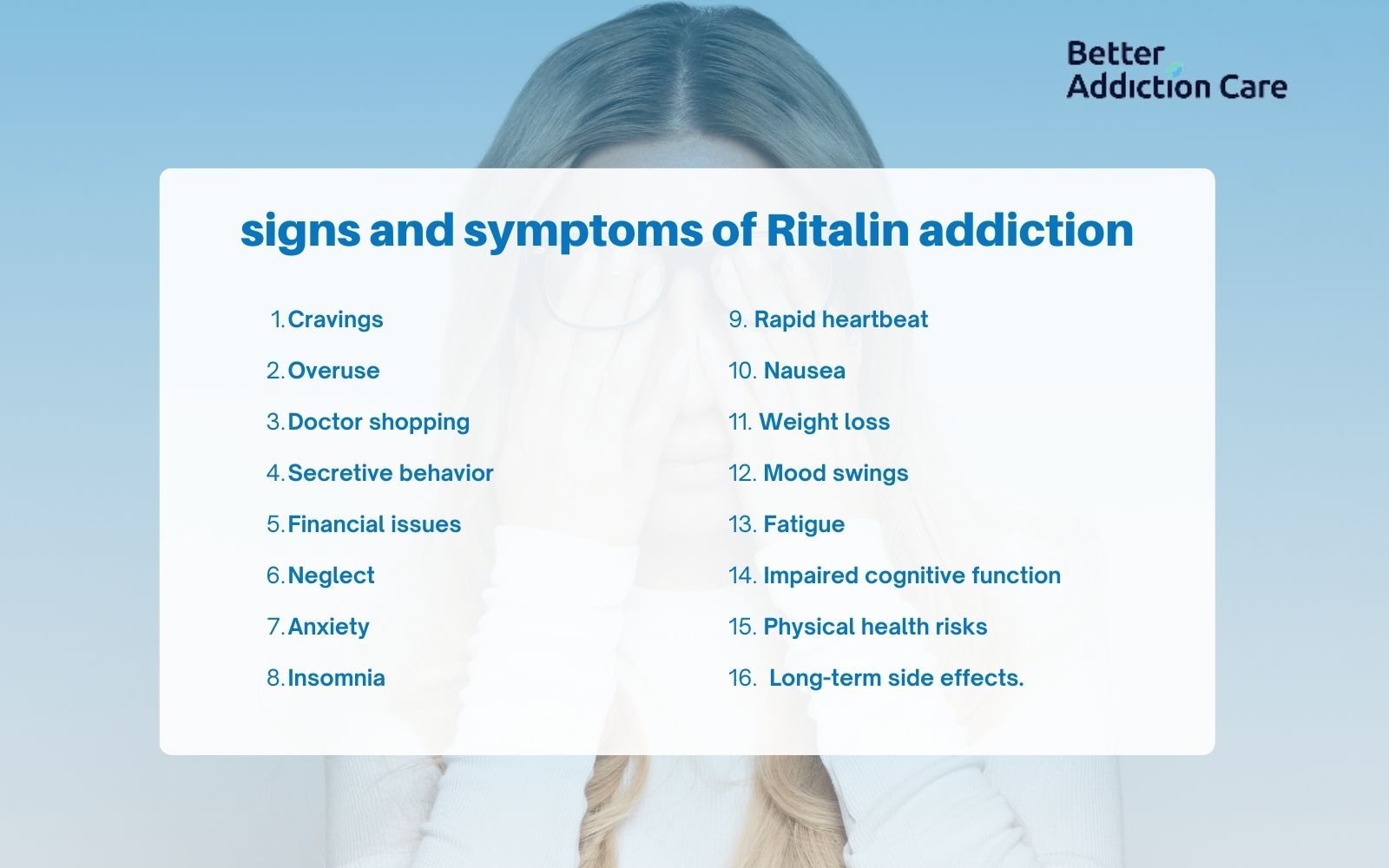
The signs and symptoms of Ritalin addiction include the following:
-
Cravings
-
Overuse
-
Doctor shopping
-
Secretive behavior
-
Financial issues
-
Neglect
-
Anxiety
-
Insomnia
-
Rapid heartbeat
-
Nausea
-
Weight loss
-
Mood swings
-
Fatigue
-
Impaired cognitive function
-
Physical health risks
-
Long-term side effects.
The symptoms of Ritalin addiction are explained below:
Cravings
Cravings are a hallmark symptom of Ritalin addiction, defined by an intense psychological and physiological urge to consume the drug despite negative consequences. This symptom is primarily psychological but has significant behavioral manifestations, driving compulsive substance-seeking behaviors that are difficult to control.
Cravings for Ritalin are particularly severe due to its impact on the brain’s dopamine system. According to a study by Volkow et al. titled “Dopamine Transporter Occupancies in the Human Brain Induced by Therapeutic Doses of Oral Methylphenidate,” published in the American Journal of Psychiatry (1995), the overstimulation of dopamine receptors caused by Ritalin leads to heightened feelings of reward and reinforcement.
Cravings not only disrupt cognitive function but also contribute to risky behaviors such as doctor shopping and illegal acquisition of Ritalin.
Overuse
Overuse is a critical symptom of Ritalin addiction, defined as consuming the drug in higher doses or more frequently than prescribed in a non-medical context. This behavior is primarily psychological and behavioral, as it reflects the compulsive need to enhance the drug’s effects or maintain its stimulating properties.
The severity of overuse is significant due to its impact on both the central nervous system and physical health. According to a study by Kollins et al. titled “Pharmacological Properties and Abuse Potential of Methylphenidate,” published in the Journal of Clinical Psychopharmacology (2001), individuals misusing Ritalin frequently escalate their dosage, with some consuming two to three times the therapeutic dose.
This pattern of overuse heightens the risk of psychiatric side effects, such as anxiety and agitation, and physical health risks, including rapid heart rate and high blood pressure.
Overuse also leads to long-term side effects, such as impaired cognitive function and addiction. It exhibits the behavioral complexity of Ritalin addiction, as users justify their excessive intake as a means to manage daily stressors or enhance productivity.
Doctor Shopping
Doctor shopping is a behavioral symptom of Ritalin addiction, defined as seeking prescriptions from multiple healthcare providers without their knowledge to obtain more of the drug. This tactic reflects a compulsive need for Ritalin and involves deception, making it a significant behavioral indicator of substance addiction.
The severity of doctor shopping lies in its role in perpetuating and escalating addiction. According to a study by McCabe et al. titled “Motivations for Nonmedical Use of Prescription Stimulants Among College Students” published in the Journal of Addiction Medicine (2009), individuals engaging in doctor shopping for stimulants like Ritalin are five times more likely to misuse higher doses than those using a single prescriber.
This behavior not only exacerbates methylphenidate abuse but also contributes to the risk of overdose and severe psychiatric side effects, such as heightened anxiety and paranoia.
Secretive Behavior
Secretive behavior is a behavioral symptom of Ritalin addiction, characterized by efforts to conceal drug use from others. This behavior includes hiding pills, lying about consumption, or creating elaborate excuses to justify actions related to acquiring or using Ritalin. It reflects the psychological need to protect the addiction and avoid judgment or intervention.
The severity of secretive behavior is high, as it often indicates advanced stages of substance addiction. According to a study by Keane et al. titled “Pleasure and Discipline in the Uses of Ritalin” published in the International Journal of Drug Policy (2008), individuals addicted to Ritalin frequently engage in deceptive practices to avoid detection, which further isolates them and fosters a cycle of dependency.
This secrecy prevents timely interventions, exacerbating the addiction’s physical and psychological toll. It requires targeted interventions, including behavioral therapy and support systems, to address the underlying causes effectively.
Financial Issues
Financial issues are behavioral and psychological symptoms of Ritalin addiction, defined by the excessive allocation of financial resources toward acquiring the drug, often at the expense of essential needs. This symptom reflects the compulsive nature of substance addiction, as individuals prioritize their access to Ritalin over financial stability.
The severity of financial issues is substantial, as they not only impact an individual’s quality of life but also contribute to social and psychological stress.
According to a study by McCabe et al. titled “Nonmedical Use of Prescription Stimulants Among Young Adults,” published in the Journal of Addictive Behaviors (2009), individuals misusing stimulants like Ritalin report spending a significant portion of their income or savings on illicitly sourced medication.
Financial instability caused by Ritalin addiction leads to further behavioral consequences, such as borrowing money, stealing, or neglecting bills, increasing the challenges of recovery and showing the need for comprehensive addiction treatment.
Neglect
Neglect is a behavioral and psychological symptom of Ritalin addiction, characterized by the disregard for personal responsibilities, relationships, and self-care. This symptom arises as individuals become increasingly consumed by their drug-seeking behaviors and usage, prioritizing Ritalin over essential aspects of daily life.
The severity of neglect is profound, as it impacts both the individual and those around them. According to a study by Keane et al. titled “Pleasure and Discipline in the Uses of Ritalin” published in the International Journal of Drug Policy (2008), individuals addicted to Ritalin frequently exhibit patterns of neglect, including failing to maintain employment, ignoring familial responsibilities, and disregarding their physical health.
The study highlights that over 40% of individuals with stimulant addiction report significant disruptions in their daily functioning due to their substance use.
Anxiety
Anxiety is a psychological and physical symptom of Ritalin addiction, defined by persistent feelings of unease, worry, or fear that are disproportionate to the situation. It results from the overstimulation of the central nervous system caused by prolonged or excessive use of Ritalin.
The severity of anxiety in Ritalin addiction is significant, as it disrupts cognitive function, emotional regulation, and daily activities.
According to a study by Volkow et al. titled “Methylphenidate Effects on Dopamine Systems,” published in the American Journal of Psychiatry (1995), chronic methylphenidate abuse leads to heightened dopamine activity, which causes increased anxiety levels.
This symptom reflects the interplay between the psychological and physical impacts of Ritalin addiction, necessitating comprehensive treatment approaches such as behavioral therapy to address both the addiction and its underlying emotional triggers.
Insomnia
Insomnia is a physical and psychological symptom of Ritalin addiction, defined as difficulty initiating or maintaining sleep due to the drug’s stimulant effects on the central nervous system. Chronic use or abuse of Ritalin disrupts natural sleep patterns, leading to persistent wakefulness and restlessness.
The severity of insomnia in Ritalin addiction is substantial, as it exacerbates other physical and mental health issues, including fatigue, irritability, and impaired cognitive function.
According to a study by Kollins et al. titled “Pharmacological Properties and Abuse Potential of Methylphenidate” published in the Journal of Clinical Psychopharmacology (2001), nearly 50% of individuals abusing Ritalin report sleep disturbances, with a direct correlation between higher doses and more severe insomnia.
Insomnia not only reflects the physical toll of methylphenidate abuse but also contributes to behavioral changes, such as increased drug-seeking behaviors to counteract fatigue, creating a vicious cycle of dependency.
Rapid Heartbeat
Rapid heartbeat, or tachycardia, is a physical symptom of Ritalin addiction characterized by an abnormally fast heart rate. This symptom arises from Ritalin’s stimulant action on the central nervous system, which increases adrenaline production and accelerates cardiovascular activity. Tachycardia manifests during periods of high-dose abuse and persists even during rest.
The severity of rapid heartbeat is substantial, as it heightens the risk of serious cardiovascular complications, including hypertension and arrhythmias.
According to a study by Crutchley and Temlett titled “Methylphenidate: Use and Abuse,” published in the South African Medical Journal (1999), tachycardia was observed in over 40% of individuals misusing methylphenidate, with higher doses correlating with increased risk. The study also notes that prolonged stimulant abuse contributes to long-term strain on the heart, increasing the likelihood of cardiac failure.
Nausea
Nausea is a physical symptom of Ritalin addiction, defined by a persistent feeling of discomfort in the stomach accompanied by an urge to vomit. This symptom results from the drug’s impact on the central nervous system and digestive tract, disrupting normal gastrointestinal functions.
The severity of nausea in Ritalin addiction varies but leads to secondary complications such as dehydration and malnutrition in prolonged cases.
According to a study by Pacella et al. titled “Gastrointestinal Effects of Stimulant Abuse” published in the Journal of Substance Abuse Treatment (2006), over 35% of individuals abusing Ritalin reported nausea as a frequent side effect, especially when taking high doses or combining the drug with alcohol.
Weight Loss
Weight loss is a physical symptom of Ritalin addiction, characterized by a significant and often unintentional reduction in body weight. This symptom occurs due to Ritalin’s stimulant effects, which suppress appetite and increase metabolic activity.
The severity of weight loss in Ritalin addiction is high, as it can lead to malnutrition, weakened immune function, and long-term health complications.
According to a study by Anthony Crutchley et al. titled “Methylphenidate Use and Abuse,” published in the South African Medical Journal (1999), individuals abusing Ritalin experience weight loss at rates 50% higher than therapeutic users, particularly when taking higher doses or combining the drug with other substances.
Prolonged weight loss results in severe physical health risks, including muscle wasting and organ dysfunction.
Mood Swings
Mood swings are a psychological and behavioral symptom of Ritalin addiction, defined by sudden and extreme changes in emotional states, ranging from euphoria to irritability or depression. These shifts result from the drug's impact on the central nervous system and its interference with dopamine regulation.
The severity of mood swings in Ritalin addiction is significant, as they disrupt relationships, impair decision-making, and exacerbate underlying mental health conditions. The abrupt highs and low mod fluctuations are linked to the rapid changes in dopamine levels caused by methylphenidate abuse.
According to a study by Keane et al. titled “Pleasure and Discipline in the Uses of Ritalin” published in the International Journal of Drug Policy (2008), nearly 60% of individuals abusing Ritalin reported experiencing frequent mood fluctuations.
The study notes that mood swings emphasize the psychological challenges of Ritalin addiction and highlight the need for behavioral therapy and psychiatric intervention to stabilize emotional regulation during recovery.
Fatigue
Fatigue is a physical and psychological symptom of Ritalin addiction, characterized by extreme tiredness and lack of energy following periods of excessive drug use or withdrawal. This symptom arises due to the overstimulation of the central nervous system during use, leading to exhaustion as the effects wear off.
The severity of fatigue in Ritalin addiction is profound, as it affects daily functioning, concentration, and physical health.
According to a study by Taherani et al., “Frequency of Methylphenidate Consumption and Its Associated Factors,” published in the Razavi International Journal of Medicine (2018), over 40% of individuals misusing Ritalin reported experiencing persistent fatigue during withdrawal phases.
Fatigue is a barrier to maintaining work and social responsibilities. This exhaustion reflects the body’s struggle to recover from the heightened energy expenditure caused by methylphenidate abuse. Fatigue shows the cyclical nature of Ritalin addiction, as individuals resort to continued drug use to combat feelings of lethargy.
What are The Causes of Ritalin Addiction?
The common causes of Ritalin addiction include self-medication, genetic predisposition, and peer pressure, misuse for cognitive enhancement. According to a study by Weyandt et al. titled “Nonmedical Prescription Stimulant Use Among College Students,” published in the Journal of Attention Disorders (2009), 17.3% of college students admitted to methylphenidate abuse, with peer pressure and academic demands being significant factors driving substance addiction.
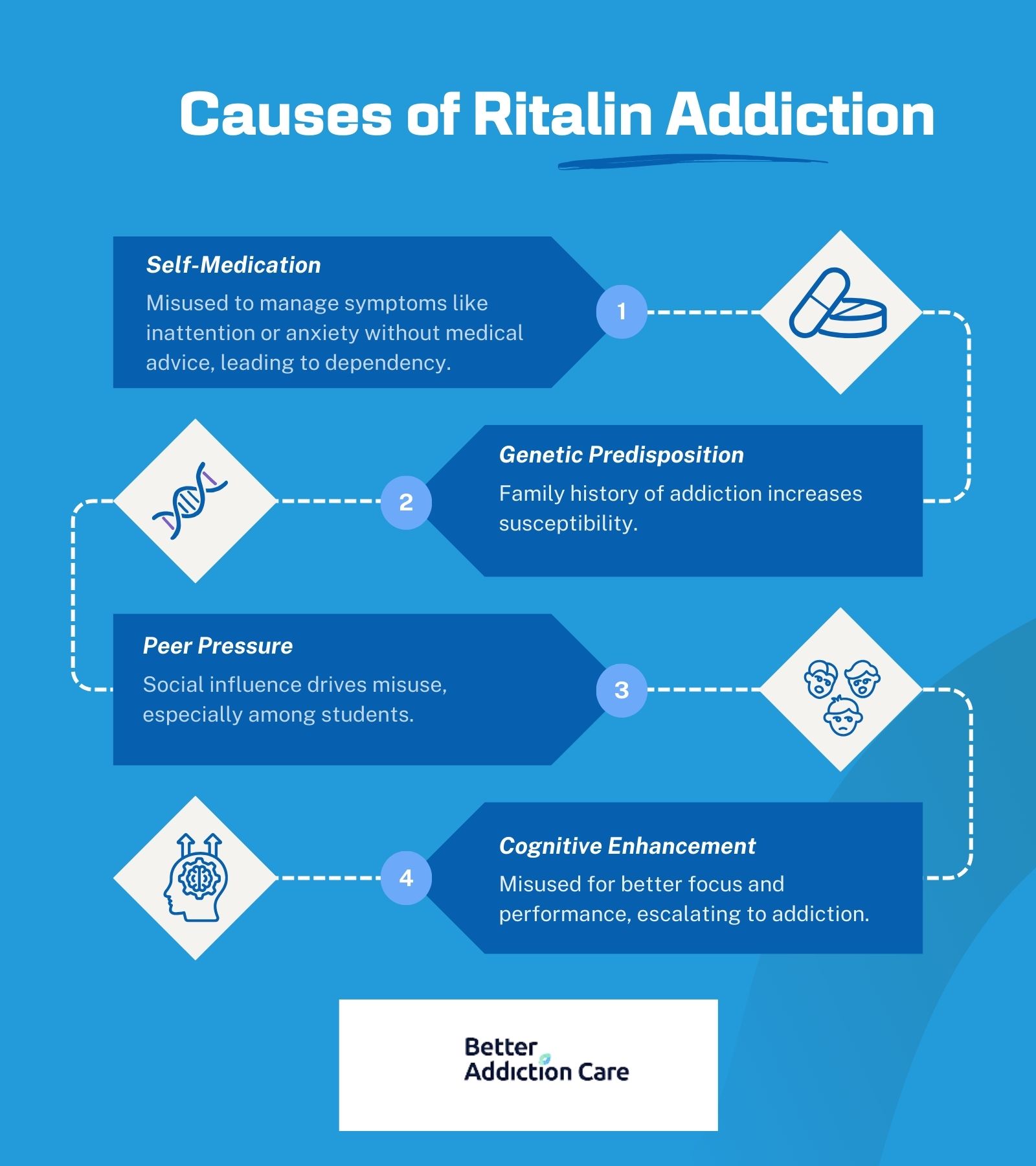
The causes of Ritalin addiction are explained below:
-
Self-Medication: Individuals misuse Ritalin to self-medicate for undiagnosed conditions such as ADHD, anxiety, or depression. They seek the drug’s stimulating effects to manage symptoms like inattention or low energy levels without consulting a healthcare professional. This behavior leads to dependency as the brain becomes reliant on Ritalin for maintaining focus and emotional balance. According to a study by Pacella et al. titled “Patterns of Stimulant Abuse in Clinical Populations” published in the Journal of Substance Abuse Treatment (2006), 30% of nonmedical Ritalin users reported self-medicating to alleviate stress and improve productivity, significantly contributing to substance addiction.
-
Genetic Predisposition: Genetic makeup plays a role in determining an individual’s susceptibility to addiction. People with a family history of substance addiction are at a higher risk of Ritalin dependency due to inherited traits affecting dopamine regulation and impulse control. This predisposition amplifies the addictive potential of methylphenidate, especially when combined with environmental triggers like high-stress situations. A study by Tremblay et al. titled “Heritability of Stimulant Abuse in Families,” published in the Journal of Addiction Medicine (2019), states that individuals with a genetic predisposition are twice as likely to misuse Ritalin compared to those without such a family history.
-
Peer Pressure: The social environment is a significant factor, especially among adolescents and college students. Peer influence normalizes the misuse of Ritalin as a tool for academic success or recreational use, making it more accessible and appealing. This social dynamic fosters behaviors such as sharing or buying Ritalin from peers, leading to a higher risk of addiction. A research by Weyandt et al. titled “Nonmedical Prescription Stimulant Use Among College Students,” published in the Journal of Attention Disorders (2009), reported that 17.3% of students admitted to misusing Ritalin, with peer pressure being a primary motivator.
-
Cognitive Enhancement: The allure of improved academic or professional performance drives individuals to misuse Ritalin, particularly in competitive environments. The drug is perceived as a solution to enhance focus, memory retention, and efficiency. However, this misuse increases dependency risk as users escalate doses to maintain the perceived benefits.
What Risk Factors Contribute to Ritalin Addiction?
The risks contributing to Ritalin addiction include peer pressure, academic stress, easy accessibility, family history, high-stress lifestyles, mental health issues, recreational use, and competitive environments. According to a study by Habibzadeh et al. titled “Illicit Methylphenidate Use Among Iranian Medical Students,” published in Drug Design, Development, and Therapy (2011), 15.7% of students who smoked and 22.2% of those who consumed alcohol were also misusing Ritalin, highlighting the strong link between lifestyle behaviors and prescription stimulant abuse.
The risk factors contributing to Ritalin addiction are explained below:
-
Peer Pressure: Peer influence significantly contributes to Ritalin misuse, especially among young adults in academic settings. The normalization of stimulant misuse in social circles encourages individuals to use the drug recreationally or for performance enhancement.
-
Academic Stress: High academic demands lead many students to misuse Ritalin, believing it will enhance focus and productivity. This pressure is particularly intense during exam periods or when faced with significant workloads. A study by Habibzadeh et al. titled “Illicit Methylphenidate Use Among Iranian Medical Students,” published in Drug Design, Development, and Therapy (2011,) revealed that 22.2% of students misusing Ritalin cited academic stress as a primary factor.
-
Easy Accessibility: Ritalin’s availability through both legitimate prescriptions and illegal markets increases its misuse. Individuals acquire the drug from peers or buy it online, bypassing the need for a prescription. Research by Keane et al. titled “Pleasure and Discipline in the Uses of Ritalin,” published in the International Journal of Drug Policy (2008), noted that college students admitted to obtaining Ritalin from friends or acquaintances.
-
Family History: Genetic predisposition plays a critical role in stimulant addiction. Individuals with a family history of substance abuse are more likely to misuse Ritalin due to inherited vulnerabilities in dopamine regulation and impulse control. A study by Tremblay et al. titled “Heritability of Stimulant Abuse in Families,” published in the Journal of Addiction Medicine (2019), found that individuals with a family history of addiction are twice as likely to develop a dependency on methylphenidate.
-
High-Stress Lifestyles: Stressful environments, whether personal or professional, often push individuals toward Ritalin misuse as a coping mechanism. This is particularly prevalent in high-pressure jobs and competitive industries where performance expectations are high. Research by Volkow et al. titled “Methylphenidate Effects on Dopamine Transporters,” published in the American Journal of Psychiatry (1995), linked high-stress lifestyles to an increased risk of stimulant misuse, particularly in individuals with pre-existing mental health conditions.
-
Mental Health Issues: Conditions such as anxiety, depression, and ADHD predispose individuals to Ritalin misuse as they seek relief from symptoms through self-medication.
-
Recreational Use: Many individuals misuse Ritalin for its euphoric effects, particularly in social or party settings. Recreational use is common among young adults who perceive the drug as a safer alternative to illicit substances. A study by Weyandt et al. titled “Nonmedical Prescription Stimulant Use Among College Students,” published in the Journal of Attention Disorders (2009), revealed that 12% of Ritalin users engaged in recreational misuse for the feeling of a high.
-
Competitive Environments: High-pressure academic or professional environments foster Ritalin misuse as individuals seek to outperform peers. This misuse is rationalized as a necessity for success. Research by Habibzadeh et al. found that students in medical fields were disproportionately likely to misuse Ritalin compared to peers in less competitive disciplines.
What are the Effects of Ritalin Addiction?
The common effects of Ritalin addiction include insomnia, weight loss, high blood pressure, anxiety, nausea, and other physical and psychological symptoms. According to a study by Crutchley et al. titled “Methylphenidate: Use and Abuse,” published in the South African Medical Journal (1999), individuals misusing Ritalin report side effects such as increased heart rate, headaches, and abdominal pain, with chronic misuse leading to long-term health risks including tics or tremors.
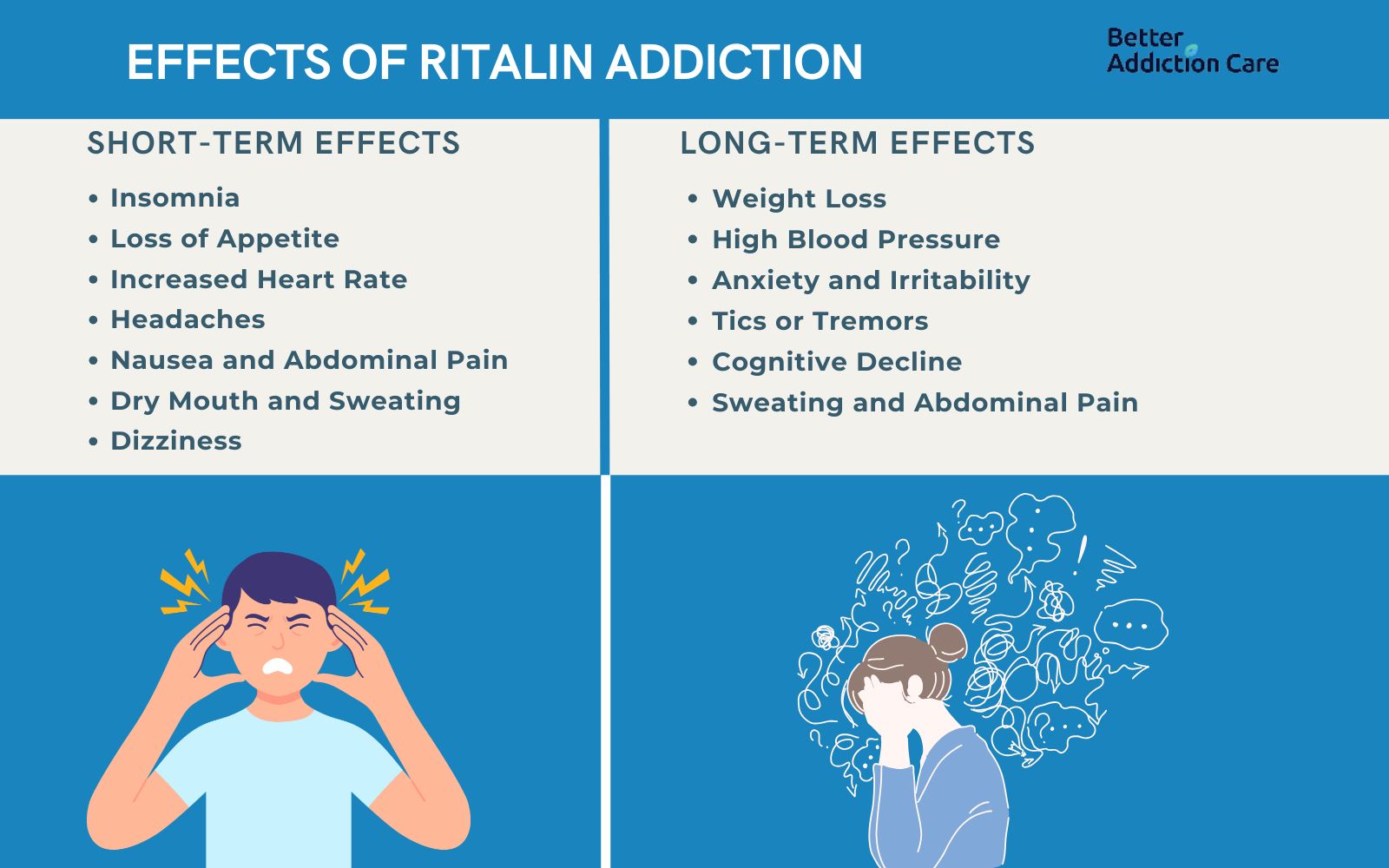
The short-term effects of Ritalin addiction are explained below:
-
Insomnia: Ritalin stimulates the central nervous system by increasing dopamine and norepinephrine activity, which enhances alertness but disrupts the brain's natural sleep-wake cycle. This overstimulation prevents users from achieving the relaxation necessary for sleep. According to Pacella et al. in “Patterns of Stimulant Abuse in Clinical Populations,” published in the Journal of Substance Abuse Treatment (2006), individuals misusing Ritalin report persistent difficulties falling or staying asleep.
-
Loss of Appetite: Ritalin activates areas of the brain responsible for regulating hunger, specifically by reducing the release of hunger-inducing hormones like ghrelin. This leads to diminished feelings of hunger, even when the body requires nourishment.
-
Increased Heart Rate: The stimulant effect of Ritalin heightens adrenaline levels, which increases the heart’s activity to pump blood faster, mimicking the body’s fight-or-flight response. This leads to tachycardia, even when the body is at rest. Crutchley et al., in “Methylphenidate: Use and Abuse,” published in the South African Medical Journal (1999), observed that Ritalin abusers experienced elevated heart rates during periods of misuse.
-
Headaches: The alteration of dopamine levels and blood vessel constriction in the brain caused by Ritalin contributes to headaches. These headaches occur when the stimulant’s effects wear off, creating a rebound effect on the vascular system. Habibzadeh et al., in “Illicit Methylphenidate Use Among Students,” published in Drug Design, Development, and Therapy (2011,) identified headaches as a frequent complaint among Ritalin users.
-
Nausea and Abdominal Pain: Ritalin disrupts the normal functioning of the digestive system by altering gastrointestinal motility and enzyme secretion. This leads to discomfort, nausea, and cramping in the abdominal region.
-
Dry Mouth and Sweating: By stimulating the sympathetic nervous system, Ritalin reduces saliva production and activates sweat glands, leading to dry mouth and excessive sweating. These symptoms worsen with increased dosages or frequent use.
-
Dizziness: Ritalin’s impact on blood pressure regulation causes a sudden drop in oxygen supply to the brain, resulting in dizziness or lightheadedness. This symptom is common during the onset of the drug’s effects or when its concentration in the bloodstream fluctuates.
The long-term effects of Ritalin addiction are explained below:
-
Weight Loss: Prolonged suppression of appetite due to chronic Ritalin misuse can lead to significant weight loss. Over time, this causes malnutrition, muscle wasting, and weakened immunity. Crutchley et al. (1999) reported that long-term users experienced substantial weight loss, increasing the risk of severe physical health complications.
-
High Blood Pressure: Continuous stimulation of the cardiovascular system by Ritalin results in persistent vasoconstriction, leading to elevated blood pressure. This chronic strain on blood vessels increases the likelihood of hypertension and related cardiac disorders. Volkow et al. (1995) highlighted that long-term users of Ritalin face a twofold risk of developing hypertension compared to therapeutic users.
-
Anxiety and Irritability: Prolonged overstimulation of dopamine receptors disrupts emotional regulation, leading to heightened stress responses and irritability. Over time, this creates a baseline of anxiety that persists even during withdrawal. McCabe et al., in “Nonmedical Use of Prescription Stimulants,” published in the Journal of Addictive Behaviors (2009), found that long-term users reported chronic anxiety and mood instability.
-
Tics or Tremors: Chronic stimulation of the central nervous system causes neurological effects such as involuntary muscle movements or tremors. These symptoms result from active neural pathways involved in motor control. Habibzadeh et al. (2011) noted that tics and tremors are significant complications in long-term stimulant misuse cases.
-
Cognitive Decline: Long-term Ritalin abuse impairs cognitive functions, such as memory and decision-making, due to alterations in the brain’s dopamine system. These changes reduce the brain's ability to maintain normal cognitive processing without the drug.
-
Sweating and Abdominal Pain: Persistent overactivation of the sympathetic nervous system causes excessive sweating and chronic gastrointestinal discomfort. These symptoms worsen as tolerance to the drug builds, requiring higher doses to achieve the same effects.
What are The Effects of Ritalin Gummies?
The effects of Ritalin gummies include increased alertness, reduced appetite, insomnia, elevated heart rate, and heightened anxiety, particularly when misused or taken in excessive doses.
These gummies, like other methylphenidate formulations, act by increasing dopamine and norepinephrine activity in the brain, which enhances focus but also raises the potential for addiction and side effects.
According to a study by Keane et al. titled “Pleasure and Discipline in the Uses of Ritalin” published in the International Journal of Drug Policy (2008), nonmedical use of alternative Ritalin formulations has been linked to an elevated risk of dependency due to the ease of consumption and misuse.
The convenience and perceived safety of Ritalin gummies lead users to underestimate their potency, increasing the likelihood of overuse. According to the National Institute on Drug Abuse (NIDA), fo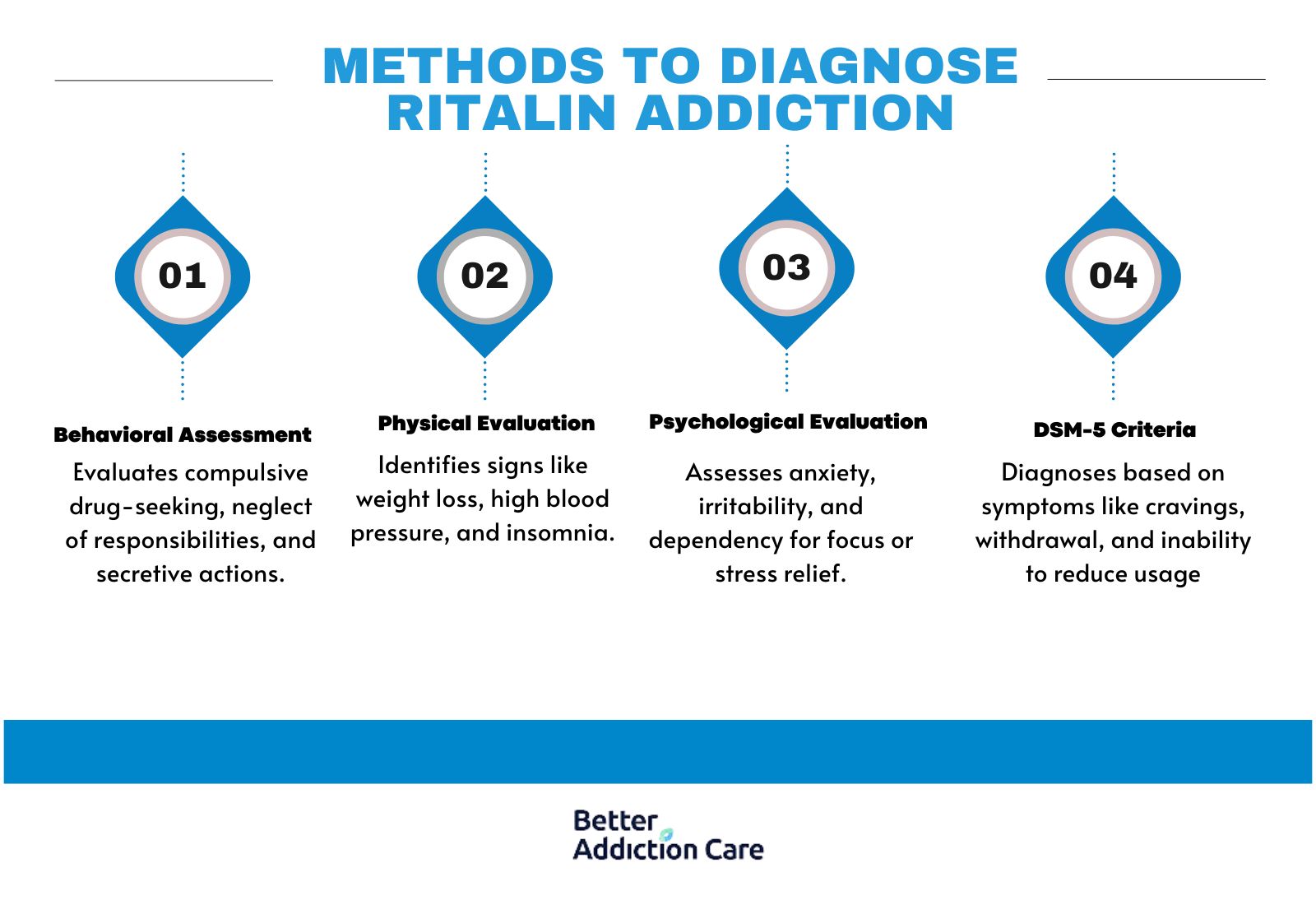 se of consumption and potential for abuse.
se of consumption and potential for abuse.
Long-term misuse of Ritalin gummies results in significant physical and psychological consequences, such as weight loss, high blood pressure, and severe anxiety.
How is Ritalin Addiction Diagnosed?
To diagnose Ritalin addiction, clinicians and psychatrists use methods like behavioral assessment, physical evaluation, psychological evaluation, and DSM-5 criteria to assess patterns of misuse, psychological dependence, and physical symptoms for stimulant use disorders.
According to a study by Madrigal and Marshall titled "Analysis of Ritalin Addiction and Recovery From Both a Physical and Psychological Lens," published in the Longwood University Research Showcase (2021), the diagnostic process involves identifying compulsive behaviors, such as excessive cravings, alongside physical symptoms like fatigue and anxiety.
Methods to diagnose Ritalin addiction are explained below:
-
Behavioral Assessment: Clinicians evaluate behaviors such as compulsive drug-seeking, neglect of responsibilities, and secretive actions like doctor shopping. These behaviors are strong indicators of Ritalin addiction, as they reveal the individual's inability to regulate their usage.
-
Physical Evaluation: Physical signs such as rapid weight loss, high blood pressure, and symptoms of insomnia are examined. These symptoms provide evidence of the physiological toll of Ritalin misuse, especially in cases where the drug is consumed in high doses or over long periods.
-
Psychological Evaluation: Mental health professionals assess emotional and cognitive changes, including heightened anxiety, irritability, and dependency on the drug for focus or stress management. These evaluations help determine the psychological impacts of Ritalin abuse, which are intertwined with addiction.
-
DSM-5 Criteria: Diagnosis is formalized using the DSM-5 criteria for stimulant use disorders. This involves identifying specific symptoms such as cravings, inability to reduce usage despite negative consequences, and withdrawal symptoms when the drug is unavailable.
According to Madrigal and Marshall, this multifaceted diagnostic approach ensures that the physical, psychological, and behavioral aspects of addiction are thoroughly addressed.
How is Ritalin Addiction Treated?
Ritalin addiction is commonly treated through Cognitive Behavioral Therapy (CBT), detoxification, and rehab programs.
According to the study by Madrigal and Marshall titled "Analysis of Ritalin Addiction and Recovery From Both a Physical and Psychological Lens," published in Longwood University Research Showcase (2021), rehab programs incorporating CBT and Motivational Interviewing (MI) significantly enhance recovery outcomes by addressing both physical dependence and psychological triggers.
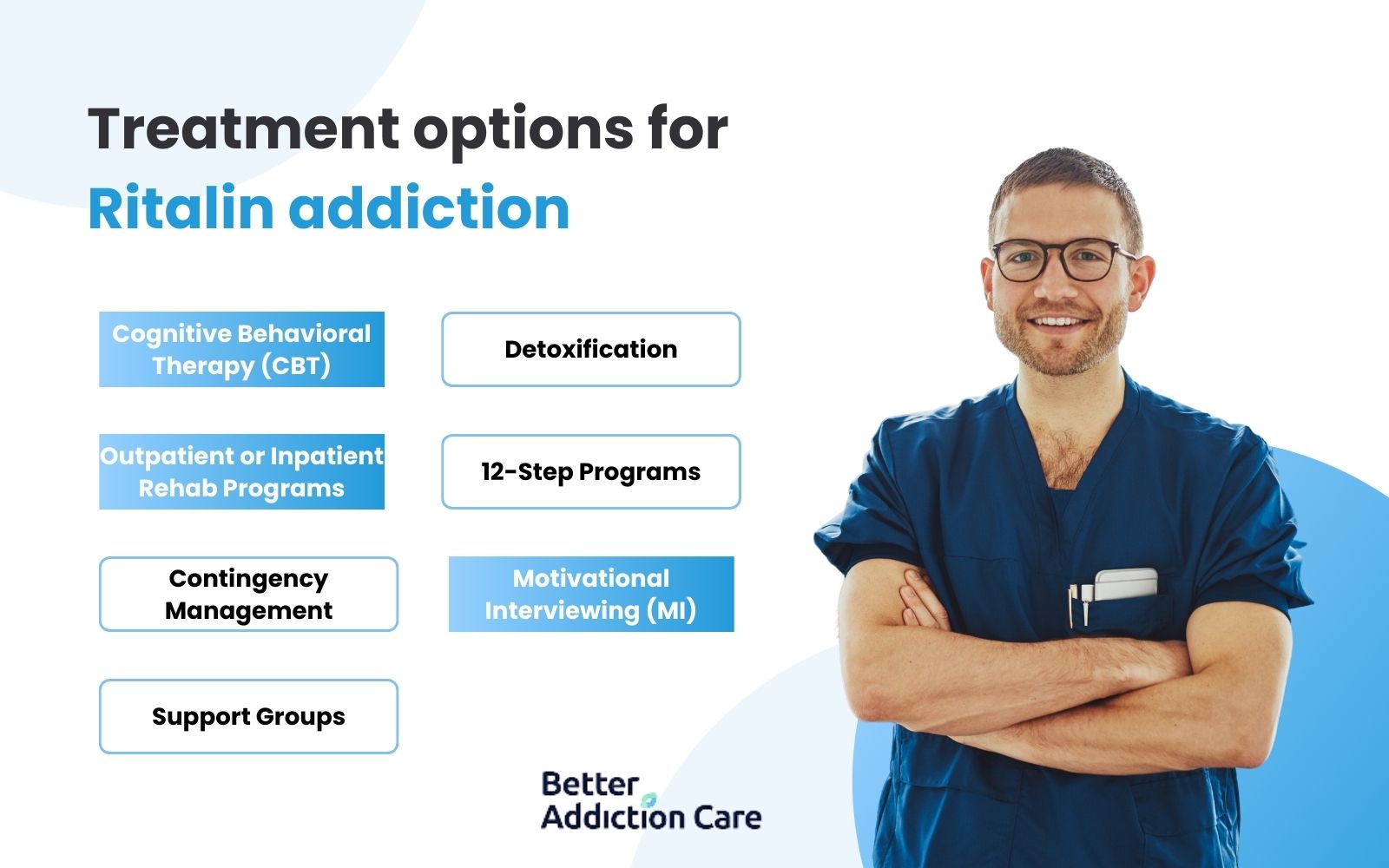
Treatment options for Ritalin addiction are explained below:
Cognitive Behavioral Therapy (CBT)
CBT is a cornerstone of addiction treatment, focusing on identifying and changing negative thought patterns and behaviors that fuel substance use. For Ritalin addiction, CBT helps individuals understand triggers, manage cravings, and develop healthier coping strategies for stress and emotional challenges.
This therapy also addresses co-occurring disorders such as anxiety or depression, which are common among those who misuse stimulants. According to Smith and Baker in their study titled “Effectiveness of CBT in Treating Prescription Stimulant Abuse,” published in the Journal of Clinical Psychology (2019), CBT improves long-term recovery rates by 50-60%, particularly when paired with detoxification and medication.
Detoxification
Detoxification is the first step in treating Ritalin addiction, aimed at safely managing withdrawal symptoms like fatigue, insomnia, and irritability. Medical supervision ensures that patients receive support for symptoms such as anxiety or rapid heart rate, which arise during withdrawal.
Medications such as benzodiazepines are prescribed to manage severe anxiety or agitation, while beta-blockers address elevated heart rates. According to Johnson et al. in “The Role of Medically Supervised Detoxification in Treating Stimulant Addiction,” published in the Substance Abuse Review (2018), patients who complete medically supervised detox are better prepared for subsequent treatment.
Outpatient or Inpatient Rehab Programs
These programs provide a structured environment where individuals receive therapy, counseling, and medical care tailored to their level of addiction severity. Inpatient programs are recommended for severe cases, offering 24/7 monitoring and intensive therapeutic interventions.
Outpatient programs, on the other hand, allow patients to continue their daily responsibilities while attending scheduled treatment sessions. A study by Marshall et al. titled “Rehabilitation Outcomes in Stimulant Addiction Treatment” published in the Addiction Medicine Journal (2020) reported a success rate for inpatient programs in maintaining sobriety for six months or longer.
12-Step Programs
These peer-led programs, modeled after Alcoholics Anonymous, focus on personal accountability, spiritual growth, and community support to sustain recovery. Participants work through structured steps to understand their addiction and build healthier lifestyles.
The support of peers who share similar struggles fosters a sense of belonging and reduces isolation, which is necessary for recovery. Thompson et al., in “Peer Support in 12-Step Programs for Prescription Drug Addiction,” published in the Journal of Substance Use (2017), found that consistent attendance at 12-step meetings reduces relapse rates during the first year of recovery.
Contingency Management
The contingency management approach uses tangible rewards, such as vouchers or privileges, to encourage abstinence and adherence to treatment. For example, patients receive incentives for clean drug tests or completing therapy sessions.
This method is particularly effective in promoting engagement in long-term treatment. A study by Patel et al. titled “Incentive-Based Approaches in Stimulant Addiction Recovery” published in the American Journal of Psychiatry (2019) found that contingency management increased treatment retention rates by 30% compared to traditional methods.
Motivational Interviewing (MI)
MI is designed to strengthen a patient’s intrinsic motivation to change by exploring their ambivalence toward quitting Ritalin. It is particularly effective for individuals who are unsure about committing to recovery. By fostering self-efficacy and personal responsibility, MI helps reduce the risk of relapse.
Support Groups
Peer-led support groups offer emotional and social support crucial for maintaining long-term recovery. These groups provide a space for individuals to share their experiences, learn coping strategies, and build a sense of community.
This collective support helps reduce feelings of isolation and fosters accountability. According to Roberts et al., “The Role of Peer Support in Managing Prescription Stimulant Addiction,” published in the Journal of Community Psychology (2018), regular participation in support groups reduces relapse rates by 33% within the first six months of recovery.
Is Naltrexone Effective in Treating Ritalin Addiction?
No, Naltrexone is not used to treat Ritalin addiction, as it is primarily effective for opioid and alcohol addiction. While Naltrexone works by blocking the euphoric effects of substances like opioids and alcohol, its effectiveness in treating stimulant addiction, such as Ritalin, is less established.
According to a study by Moten et al. titled “Naltrexone in Stimulant Addiction Treatment: Evidence and Challenges,” published in the Journal of Substance Abuse Treatment (2017), while there is some preliminary evidence supporting Naltrexone’s role in managing cravings for stimulants, it has not proven as effective in treating Ritalin addiction compared to other approaches like behavioral therapy.
Because Ritalin addiction affects the brain’s dopamine system differently than opioids or alcohol, Naltrexone is generally not the first-line treatment for stimulant dependence.
Research by Lee et al. in “Pharmacological Treatments in Stimulant Use Disorder,” published in Current Psychiatry Reports (2019), supports this, indicating that more specialized treatments like Cognitive Behavioral Therapy (CBT) and contingency management are far more effective for treating stimulant addiction.
What are The Withdrawal Symptoms of Ritalin Addiction Addiction?
The withdrawal symptoms of Ritalin addiction are primarily psychological and physical, including insomnia, depression, fatigue, and severe cravings for the drug. These symptoms are significantly disruptive and lead to mood swings, irritability, and physical discomfort, such as headaches and muscle pain.
The severity of these withdrawal symptoms varies based on the individual and the extent of their dependence on the drug. According to the National Institute on Drug Abuse (NIDA), stimulant withdrawal also results in intense psychological distress, manifesting as anxiety, depression, and increased risk of relapse if not properly managed through therapeutic interventions like Cognitive Behavioral Therapy (CBT).
The withdrawal symptoms of Ritalin addiction are explained below:
-
Insomnia: One of the most common withdrawal symptoms is insomnia, which occurs as the body adjusts to the absence of Ritalin’s stimulant effects. Ritalin enhances dopamine and norepinephrine in the brain, which promotes wakefulness. When the drug is no longer present, individuals experience difficulty sleeping. According to Volkow et al. in “Methylphenidate and the Brain,” published in the American Journal of Psychiatry (1995), the sudden absence of these neurotransmitters leads to sleep disturbances in many users.
-
Depression: Depression is another primary withdrawal symptom, as Ritalin’s effect on dopamine regulation leads to a deficiency in the brain’s reward system once the drug is discontinued. The body becomes reliant on the drug to produce the "feel-good" chemicals, and without it, individuals experience feelings of sadness or hopelessness. Research by Dackis and O'Brien in “A Critical Review of Pharmacological Treatment for Stimulant Addiction,” published in Addiction (2007,) shows that stimulant withdrawal results in depressive symptoms, which are exacerbated by the abrupt cessation of the drug.
-
Fatigue: As Ritalin stimulates the central nervous system, individuals abusing the drug often experience a heightened state of energy and alertness. When stopping use, the body experiences extreme fatigue as it tries to restore its natural energy levels. According to McCabe et al. in “Prescription Stimulant Abuse Among College Students,” published in The Journal of Clinical Psychiatry (2009), individuals withdrawing from Ritalin report feeling physically exhausted and drained due to the depletion of neurotransmitters involved in regulating energy.
-
Cravings: Cravings for Ritalin are common during withdrawal, as the brain craves the dopamine rush associated with the drug. This can lead to intense urges to relapse and reinitiate drug use to satisfy those cravings. Research by Pacella et al. in “Patterns of Stimulant Abuse in Clinical Populations,” published in the Journal of Substance Abuse Treatment (2006), noted that cravings persist throughout the withdrawal phase, further complicating recovery.
-
Irritability and Mood Swings: Ritalin withdrawal leads to irritability and mood swings, as the drug’s impact on neurotransmitters like dopamine and norepinephrine stabilizes after discontinuation. The abrupt drop in these chemicals causes emotional instability, leading to increased frustration or anger. Studies like those by Volkow et al. (1995) have linked stimulant withdrawal to changes in mood regulation, manifesting as irritability.
Can You Overdose on Ritalin?
Yes, you can overdose on Ritalin. Overdosing on Ritalin occurs when individuals take a higher dose than prescribed, either intentionally to experience euphoria or accidentally. High doses of Ritalin lead to severe cardiovascular issues such as increased heart rate, elevated blood pressure, and, in severe cases, heart attacks or strokes.
Ritalin overdoses also result in symptoms such as agitation, hallucinations, seizures, and even death in extreme cases. According to the National Institute on Drug Abuse (NIDA), Ritalin abuse has led to emergency room visits and hospitalizations due to the toxic effects of overdosing.
The American Association of Poison Control Centers (AAPCC) recorded over 2,100 cases of Ritalin overdose in the U.S. in 2021, with many cases involving adolescents who misused the drug.
The risk of overdose increases with the misuse of Ritalin, especially when taken in combination with other substances.
Who is at Risk of Ritalin Addiction?
People at risk of Ritalin addiction include those who misuse the drug recreationally, individuals with ADHD, and those exposed to high levels of stress or peer pressure. The risk increases significantly for college students, particularly those engaged in highly competitive environments or using the drug for academic enhancement.
People at risk of Ritalin addiction are explained below:
-
Individuals Who Misuse Ritalin Recreationally: People who take Ritalin for recreational purposes, such as enhancing focus, alertness, or achieving a euphoric feeling, are at high risk of developing an addiction. The stimulant effects on the brain's dopamine system create feelings of pleasure, which can reinforce the behavior and lead to dependency. According to McCabe et al. in “Motivations for Nonmedical Use of Prescription Stimulants,” published in the Journal of Addictive Behaviors (2009), individuals who misuse Ritalin for these reasons are particularly vulnerable to addiction as they continue to chase the stimulating effects.
-
Individuals with ADHD: People with ADHD are prescribed Ritalin as a treatment to help improve focus and manage symptoms of hyperactivity. However, individuals with ADHD are also more susceptible to misuse of the drug in higher doses due to the brain's altered dopamine system. This group faces a higher risk because they become reliant on the stimulating effects for cognitive or emotional regulation. According to research by McGough et al. in “ADHD and Prescription Stimulant Misuse,” published in the Journal of Clinical Psychopharmacology (2013), individuals with ADHD have a higher likelihood of misusing Ritalin due to the need to enhance their focus or control symptoms of impulsivity.
-
College Students and Young Adults: College students and young adults are especially at risk for Ritalin addiction due to the pressure to perform academically or socially. Many students misuse Ritalin to gain a cognitive edge during exams or to fit in with peers who are also misusing prescription stimulants. The pressure to succeed in competitive environments contributes significantly to the likelihood of misusing the drug.
Is Ritalin Addictive When Used as Prescribed?
Yes, Ritalin can be addictive even when used as prescribed, especially if taken in high doses or misused by individuals for purposes other than medical treatment. While Ritalin is supposed to be safe when used according to a doctor's instructions for managing ADHD or narcolepsy, the potential for misuse arises when individuals use the drug to enhance cognitive function, stay awake, or experience its stimulant effects.
Ritalin does not generally lead to addiction in most individuals with ADHD. Still, its stimulant properties make it susceptible to abuse in certain groups, particularly adolescents and young adults. The Drug Enforcement Administration (DEA) has classified Ritalin as a Schedule II substance, signifying its high potential for abuse, which contributes to the risk of addiction.
Is Ritalin Misuse Common Among Students?
Yes, Ritalin misuse is common among students, particularly in academic environments where high pressure to perform leads some to misuse stimulants like Ritalin for cognitive enhancement.
Students perceive Ritalin as a tool to improve focus, memory, and mental clarity during intense study periods, exams, or when attempting to meet academic deadlines. Additionally, social pressure and the normalization of academic cheating or drug use contribute to the growing misuse of prescription stimulants among students.
According to the National Institute on Drug Abuse (NIDA), approximately 5% of college students report using prescription stimulants like Ritalin non-medically to enhance academic performance, making it one of the most commonly misused prescription drugs on campuses.
The appeal lies in Ritalin’s stimulant properties, which increase dopamine levels in the brain, leading to enhanced alertness and concentration. However, the misuse of Ritalin among students, especially in competitive academic settings, leads to dependency and other harmful physical and psychological effects.
What Happens When You Combine Ritalin and Alcohol?
When Ritalin is combined with alcohol, it causes several dangerous effects, such as increased risk of overdose, cardiovascular complications, and impaired cognitive and motor function. Ritalin, a stimulant, increases dopamine production, leading to heightened alertness, while alcohol, a depressant, reduces brain activity.
This combination masks the depressant effects of alcohol, prompting individuals to consume more alcohol, which increases the risk of alcohol poisoning. Moreover, the simultaneous use of Ritalin and alcohol results in elevated heart rate, high blood pressure, and increased risk of heart attack or stroke.
These compounded effects cause extreme dehydration, impaired decision-making, and an increased likelihood of accidents. According to the National Institute on Drug Abuse (NIDA), combining stimulants like Ritalin with alcohol interferes with a person’s ability to think clearly and make safe decisions, heightening the risk of physical harm or engaging in risky behaviors.
What is The Difference Between Ritalin Addiction and Adderall Addiction?
The main difference between Ritalin addiction and Adderall addiction is their pharmacological properties. They contain different active ingredients and result in varying addiction profiles due to their distinct pharmacological properties.
Ritalin, which contains methylphenidate, primarily affects dopamine reuptake in the brain. In contrast, Adderall, which contains a mixture of amphetamine salts, works by increasing both dopamine and Norepinephrine.
Adderall addiction has been reported by the National Institute of Drug Abuse to be more common than Ritalin addiction, especially among college students, due to its perceived effectiveness in boosting focus and academic performance.
According to the National Institute on Drug Abuse (NIDA), 5.7% of college students reported non-medical use of prescription stimulants like Adderall in the past year, using it for academic enhancement.
Ritalin, though misused, generally has a slightly lower reported misuse rate. Adderall’s more potent stimulant effects make it more likely to be misused for recreational purposes, heightening the risk of addiction compared to Ritalin.
What is The Difference Between Ritalin Addiction and Cocaine Addiction?
The main difference between Ritalin addiction and cocaine addiction is their pharmacological effects and the manner in which they interact with the brain's reward system. Both Ritalin (methylphenidate) and cocaine are stimulant drugs that affect dopamine, a neurotransmitter in the brain that is involved in pleasure and reward.
However, while both drugs increase dopamine levels, Ritalin is prescribed for therapeutic purposes, especially for managing ADHD, whereas cocaine is an illicit drug known for its potent euphoric effects.
Ritalin, when abused, mimics the effects of cocaine, especially when taken in higher doses or through methods like snorting, leading to a similar "high" as cocaine. However, cocaine use leads to more intense addiction and greater physical and psychological dependence due to its stronger effects on the dopamine system and its rapid onset.
According to the National Institute on Drug Abuse (NIDA), about 1.5 million people in the United States misused prescription stimulants like Ritalin in 2019, whereas cocaine addiction affects about 2.1 million individuals. These numbers show while Ritalin misuse is significant, cocaine addiction remains a primary public health concern.
What is The Difference Between Ritalin Addiction and Alcohol Addiction?
The main difference between Ritalin addiction and alcohol addiction is their effects on the central nervous system and the underlying mechanisms of dependency.
Ritalin addiction is primarily driven by its classification as a stimulant, which increases dopamine levels and enhances focus and alertness, leading to dependency due to its euphoric effects when misused. Conversely, alcohol addiction stems from its dual action as both a stimulant and a depressant, initially producing euphoria but ultimately causing sedation and long-term physical damage such as liver disease.
According to the National Institute on Alcohol Abuse and Alcoholism, approximately 14.5 million Americans aged 12 and older had alcohol use disorder in 2019. In contrast, the prevalence of stimulant misuse, including Ritalin, is significantly lower but concerning, particularly among college students, where up to 16% report non-medical use for cognitive enhancement.


